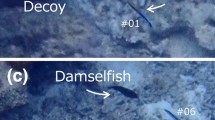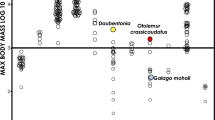Abstract
We exposed the freshwater amphipod Gammarus lacustris, to chemical stimuli from injured conspecifics and to chemical stimuli from two types of natural predators: dragonfly larvae (Aeshna eremita) and northern pike (Esox lucius). Exposure to all three stimuli caused G. lacustris to reduce significantly its level of activity relative to activity recorded in response to a distilled water control. The similarity in responses to chemicals associated with predators and to injured conspecifics suggests the presence of an alarm pheromone within the body tissues of G. lacustris. In response to chemical stimuli from pike, G. lacustris tended to reduce its time in the water column and spend more time near the bottom of the test aquaria. However, no such trend was apparent in response to chemical stimuli from dragonfly larvae. The differences in response to chemical stimuli from pike and larval dragonflies suggest that G. lacustris does not have a rigid behavioral response to predation risk; instead, antipredator behavior may be modified to maximize avoidance of predators that are active in different microhabitats.
Similar content being viewed by others
REFERENCES
ANDERSEN, T. H., FRIBERG, N., HANSEN, H. O., IVERSEN, T. M., JACOBSEN, D., and KRØJGAARD, L. 1993. The effects of introduction of brown trout (Salmo trutta L.) on Gammarus pulex L. drift and density in two fishless Danish streams. Arch. Hydrobiol. 126:361–371.
ANDERSSON, K. G., BRÖNMARK, C., HERRMANN, J., MALMQVIST, B., OTTO, C., and SJORSTROM, P. 1986. Presence of sculpins (Cottus gobio) reduces drift and activity of Gammarus pulex (Amphipoda). Hydrobiologia 133:209–215.
BOATES, J. S., FORBES, M., ZINCK, M., and MCNEIL, N. 1995. Male amphipods (Corophium volutator [Pallas]) show flexible behaviour in relation to risk of predation by sandpipers. Ecoscience 2:123–128.
BOUSFIELD, E. L. 1958. Fresh-water amphipod crustaceans of glaceated North America. Can. Field Nat. 72:55–113.
BRODIE, E. D., JR., FORMANOWICZ., D. R., JR., and BRODIE, E. D., III. 1991. Predator avoidance and antipredator mechanisms: distinct pathways to survival. Ethol. Ecol. Evol. 3:73–77.
BROWN, G. E., CHIVERS, D. P., and SMITH, R. J. F. 1995. Localized defecation by pike: A response to labelling by cyprinid alarm pheromone? Behav. Ecol. Sociobiol. 36:105–110.
BROWN, W. L., EISNER, T., and WHITTAKER, R. H. 1970. Allomones and kairomones: Transpecific chemical messengers. BioScience 20:21–22.
CHAPMAN, C. A., and MACKAY, W. C. 1984. Direct observation of habitat utilization by northern pike. Copeia 1984:255–258.
CHAPMAN, L. J., and MACKAY, W. C. 1990. Ecological correlates of feeding flexibility in northern pike (Esox lucius). J. Freshwater Ecol. 5:313–322.
CHAPMAN, L. J., MACKAY, W. C., and WILKINSON, C. W. 1989. Feeding flexibility in northern pike (Esox lucius): Fish versus invertebrate prey. Can. J. Fish. Aquat. Sci. 46:666–669.
CHIVERS, D. P., WISENDEN, B. D., and SMITH, R. J. F. 1996. Damselfly larvae leam to recognize predators from chemical cues in the predator's diet. Anim. Behav. 52:315–320.
CLIFFORD, H. F. 1969. Limnological features of a northern brown-water stream with special reference to the life histories of the aquatic insects. Am. Midl. Nat. 82:578–597.
CORBET, P. S. 1962. A Biology of Dragonflies. Quadrangle Books, Illinois.
DE MARCH, B. G. E. 1982. Decreased day length and light intensity as factors inducing reproduction in Gammarus lacustris lacustris Sars. Can. J. Zool. 60:2962–2965.
DODSON, S. I., CROWL, T. A., PECKARSKY, B. L., KATS, L. B., COVICH, A. P., and CULP, J. M. 1994. Non-visual communication in freshwater benthos: An overview. J. North Am. Benthol. Soc. 13:268–282.
GELOWITZ, C. M., MATHIS, A., and SMITH, R. J. F. 1993. Chemosensory recognition of northern pike (Esox lucius) by brook stickleback (Culaea inconstans): Population differences and the influence of predator diet. Behaviour 127:105–118.
HAZLETT, B. A. 1994. Alarm responses in the crayfish Orconectes virilis and Orconectes propinquus. J. Chem. Ecol. 20:1525–1535.
HEWS, D. K. 1988. Alarm response in larval western toads, Bufo boreas: release of larval chemicals by a natural predator and its effect on predator capture efficiency. Anim. Behav. 36:125–133.
HEWS, D. K., and BLAUSTEIN, A. R. 1985. An investigation of the alarm response in Bufo boreas and Rana cascadae tadpoles. Behav. Neural Biol. 43:47–57.
HOLOMUZKI, J. R., and HOYLE, J. D. 1990. Effect of predatory fish presence on habitat use and diel movement of the stream amphipod, Gammarus minus. Freshwater Biol. 24:509–517.
HOWE, N. R., and SHEIKH, Y. M. 1975. Anthopleurine: A sea anemone alarm pheromone. Science 189:386–388.
HYNES, H. B. N. 1955. The reproductive cycle of some British freshwater Gammaridae. J. Anim. Ecol. 24:352–387.
MARTEL, G., and DILL, L. M. 1995. Influence of movement by coho salmon (Oncorhynchus kisutch) parr on their detection by common mergansers (Mergus merganser). Ethology 99:139–149.
MATHIS, A., and HOBACK, W. W. 1997. The influence of chemical stimuli from predators on precopulatory pairing by the amphipod, Gammarus pseudolimnaeus. Ethology 103:33–40.
MATHIS, A., and SMITH, R. J. F. 1993a. Chemical alarm signals increase the survival time of fathead minnows (Pimephales promelas) during encounters with northrn pike (Esox lucius). Behav. Ecol. 4:260–265.
MATHIS, A., and SMITH, R. J. F. 1993b. Chemical labeling of northern pike (Esox lucius) by the alarm pheromone of fathead minnows (Pimephales promelas). J. Chem. Ecol. 19:1967–1979.
MATHIS, A., and SMITH, R. J. F. 1993c. Fathead minnows, Pimephales promelas, learn to recognize northern pike, Esox lucius, as predators on the basis of chemical stimuli from minnows in the pike's diet. Anim. Behav. 46:645–656.
MENON, P. S. 1969. Population ecology of Gammarus lacustris Sars in Big Island Lake. I. Habitat preference and relative abundance. Hydrobiologia 33:14–32.
MERRITT, R. W., and CUMMINS, K. W. 1984. An Introduction to the Aquatic Insects of North America, 2nd ed. Kendall/Hunt Publishing, Dubuque, Iowa.
PARKER, D. A., and SHULMAN, M. J. 1986. Avoiding predation: alarm responses of Caribbean sea urchins to simulated predation on conspecific and heterospecific sea urchins. Mar. Biol. 93:201–208.
PENNAK, R. W. 1978. Freshwater Invertebrates of the United States, 2nd ed. John Wiley & Sons, New York.
PRITCHARD, G. 1964. The prey of dragonfly larvae (Odonata; Anisoptera) in ponds in northern Alberta. Can. J. Zool. 42:785–800.
PRITCHARD, G. 1965. Prey capture by dragonfly larvae (Odontata; Anisoptera). Can. J. Zool. 43:271–289.
SAMMONS, S. M., SCALET, C. G., and NEUMANN, R. M. 1994. Seasonal and size-related changes in the diet of northern pike from a shallow prairie lake. J. Freshwater Ecol. 9:321–329.
SAVINO, J. F., and STEIN, R. A. 1989. Behavior of fish predators and their prey: Habitat choice between open water and dense vegetation. Env. Biol. Fish. 24:287–293.
SCRIMGEOUR, G. J., CULP, J. M., and CASH, K. J. 1994. Antipredator responses of mayfly larvae to conspecific and predator stimuli. J. North Am. Benthol. Soc. 13:299–309.
SIEGEL, S., and CASTELLAN, N. J. 1988. Nonparametric Statistics for the Behavioral Sciences, 2nd ed. McGraw-Hill, New York.
SIH, A. 1986. Antipredator responses and the perception of danger by mosquito larvae. Ecology 67:434–441.
SMITH, R. J. F. 1992. Alarm signals in fishes. Rev. Fish Biol. Fish. 2:33–63.
SMITH, W. E. 1973. Thermal tolerance of two species of Gammarus. Trans. Am. Fish. Soc. 102:431–433.
SNYDER, N. F. R. 1967. An alarm reaction of aquatic gastropods to intraspecific extract. Cornell University, Agricultural Experiment Station, New York State College of Agriculture, Ithaca, NY, Memoir 403, pp. 1–122.
SNYDER, N., and SNYDER, H. 1970. Alarm response of Diadema antillarum. Science 168:276–278.
WALKER, E. D. 1958. The Odonata of Canada and Alaska, Vol. II. University of Toronto Press, Ontario.
WELDON, P. J. 1990. Responses by vertebrates to chemicals from predators, pp. 500–521, in D. W. MacDonald, D. Muller-Schwarze, and S. E. Natynczuk (eds.). Chemical Signals in Vertebrates 5. Oxford University Press, Oxford.
WILLIAMS, D. D., and MOORE, K. A. 1982. The effect of environmental factors on the activity of Gammarus pseudolimnaeus (Amphipoda). Hydrobiologia 96:137–147.
WILLIAMS, D. D., and MOORE, K. A. 1985. The role of semiochemicals in benthic community relationships of the lotic amphipod Gammarus pseudolimnaeus: A laboratory analysis. Oikos 44:280–286.
WINFIELD, I. J., and WINFIELD, D. K. 1994. Feeding ecology of the diving ducks pochard (Aythya ferina), tufted duck (A. fuligula), scaup (A. marila) and goldeneye (Bucephala clangula) overwintering on Lough Neagh, Northern Ireland. Freshwater Biol. 32:467–477.
WOOSTER, D., and SIH, A. 1995. A review of the drift and activity responses of stream prey to predator presence. Oikos 73:3–8.
WRIGHT, D. I., and O'BRIEN, W. J. 1982. Differential location of Chaoborus larvae and Daphnia by fish: the importance of motion and visible size. Am. Midl. Nat. 108:68–73.
Author information
Authors and Affiliations
Rights and permissions
About this article
Cite this article
Wudkevich, K., Wisenden, B.D., Chivers, D.P. et al. Reactions of Gammarus lacustris to Chemical Stimuli from Natural Predators and Injured Conspecifics. J Chem Ecol 23, 1163–1173 (1997). https://doi.org/10.1023/B:JOEC.0000006393.92013.36
Issue Date:
DOI: https://doi.org/10.1023/B:JOEC.0000006393.92013.36




